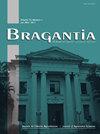低海拔地区阿拉比卡咖啡品种的初始营养发育和早期选择
IF 1.5
4区 农林科学
Q2 Agricultural and Biological Sciences
引用次数: 0
摘要
在低海拔地区种植阿拉比卡咖啡是农民收入多样化的可持续选择。考虑到可用品种的可变性,通过初始营养发育进行间接选择可能是鉴定最适合该环境的基因型的辅助工具。本研究旨在寻找在低海拔地区初始发育较好的矮型阿拉比卡咖啡品种,以及与高产潜力品种早期选育有较大关联的形态性状。这项实验是在巴西圣保罗东北部进行的。试验设计为随机分组,每组4个重复。这些处理包括17个矮化阿拉比卡咖啡品种。矮化阿拉比卡咖啡品种在初始营养发育方面存在差异。斜向分枝的生长和节数的增加可作为早期选育的依据,以甄别具有较大产量潜力的品种。栽培品种IAC Obatã 4739、Obatã IAC 1669-20和图皮IAC 1669-33在低海拔环境下表现出较高的初始营养性能。所得结果对育种者和生产者选择最适合在这种环境下栽培的品种具有指导意义。本文章由计算机程序翻译,如有差异,请以英文原文为准。
Initial vegetative development and early selection of arabica coffee cultivars in a low-altitude region
The cultivation of Coffea arabica L. in a low-altitude region is a sustainable alternative for diversifying the income of farmers. On account of the variability of available cultivars, the use of indirect selection through initial vegetative development may be an auxiliary tool for identifying the most suitable genotypes for this environment. This study aimed to identify the dwarf Arabica coffee cultivars with better initial development in a low-altitude region and the morphological traits with greater relevance for the early selection of cultivars with high yield potential. The experiment was installed in the northeast of São Paulo, Brazil. The experimental design used was randomized blocks with four replications. The treatments consisted of 17 dwarf Arabica coffee cultivars. There is variability among dwarf Arabica coffee cultivars for initial vegetative development. The growth and increase in the number of nodes of the plagiotropic branch can be used in early selection to identify cultivars with greater yield potential. The cultivars IAC Obatã 4739, Obatã IAC 1669-20, and Tupi IAC 1669-33 present higher initial vegetative performance in low-altitude environments. The results obtained are useful to breeders and producers for choosing the cultivars best adapted to cultivation in this environment.
求助全文
通过发布文献求助,成功后即可免费获取论文全文。
去求助
来源期刊

Bragantia
AGRICULTURE, MULTIDISCIPLINARY-
CiteScore
2.40
自引率
8.30%
发文量
33
审稿时长
4 weeks
期刊介绍:
Bragantia é uma revista de ciências agronômicas editada pelo Instituto Agronômico da Agência Paulista de Tecnologia dos Agronegócios, da Secretaria de Agricultura e Abastecimento do Estado de São Paulo, com o objetivo de publicar trabalhos científicos originais que contribuam para o desenvolvimento das ciências agronômicas.
A revista é publicada desde 1941, tornando-se semestral em 1984, quadrimestral em 2001 e trimestral em 2005.
É filiada à Associação Brasileira de Editores Científicos (ABEC).
 求助内容:
求助内容: 应助结果提醒方式:
应助结果提醒方式:


